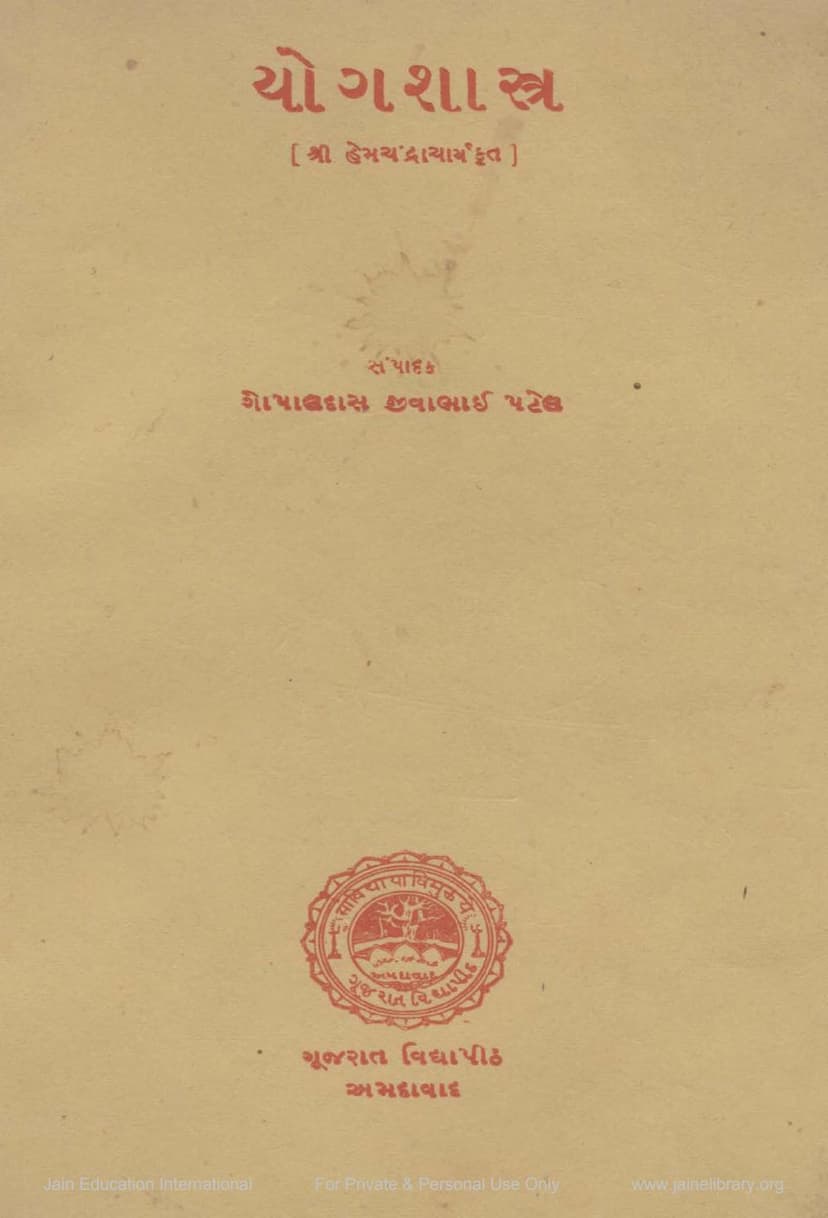Yogshastra
Added to library: September 2, 2025

Summary
Here's a comprehensive summary of the Jain text "Yogashastra" by Hemchandracharya, based on the provided information:
Book Title: Yogashastra (યોગશાસ્ત્ર) Author: Acharya Hemchandracharya (as the original author) Editor/Compiler: Gopaldas Jivabhai Patel Publisher: Gujarat Vidyapith, Ahmedabad Catalog Link: https://jainqq.org/explore/004996/1
Overall Summary:
The "Yogashastra" is a significant Jain text composed by the renowned scholar Acharya Hemchandracharya, reportedly at the request of King Kumarpala of Gujarat. The book is an exposition on the principles and practices of Yoga, presented within the framework of Jain philosophy. Unlike many traditional Yoga texts that primarily focus on ascetics or renunciates, Hemchandracharya's "Yogashastra" is notable for its emphasis on Yoga for householders (Gṛhasthadharma). It integrates the Jain path of conduct, comprising vows (Vratas), virtues, and ethical disciplines, with the broader yogic practices of meditation and concentration, presenting a holistic path to spiritual liberation.
Key Themes and Content:
-
The Supremacy of Moksha: The text begins by asserting that among the four Purusharthas (goals of human life), Moksha (liberation) is the highest, and Yoga is its cause.
-
Yoga Defined as Ratnatraya: Yoga is defined in the Jain context as the "Jewel Triumvirate" (Ratnatraya): Right Knowledge (Samyak Jnana), Right Faith (Samyak Darshana), and Right Conduct (Samyak Charitra).
-
Focus on Householder Yoga: A central aspect of the introduction and the text's structure is the adaptation of yogic principles for householders. While initially briefly addressing the monastic path (Yati Dharma), the majority of the work expands on the path for lay followers.
-
Integration of Jain Ethical Conduct: The "Yogashastra" systematically incorporates the core Jain ethical framework for laypeople, including:
- Anuvratas (Minor Vows): Five vows – Ahimsa (non-violence), Satya (truthfulness), Asteya (non-stealing), Brahmacharya (celibacy/chastity), and Aparigraha (non-possession/non-attachment) – are elaborated upon with their respective nuances and spiritual implications.
- Gunavratas (Supporting Vows): Three vows that strengthen the Anuvratas, including Digvirati (restricting movement to defined areas), Bhogopabhogapariman (limiting consumption of consumable and enjoyable things), and Anarthadanda (abstaining from purposeless acts or speech).
- Shikshavratas (Training Vows): Four vows designed for spiritual training: Samayika (equanimity for a period), Deshavakashika (restricting actions to specific times and places), Paushadha (observing a mini-ascetic day), and Atithisamvibhaga (offering charity to the deserving).
- Aticharas (Transgressions): The text also details the minor deviations or transgressions (Aticharas) related to each vow, highlighting common pitfalls.
-
The Path to Self-Realization: The "Yogashastra" delves into the means of achieving self-knowledge and liberation, focusing on the conquest of:
- Kashayas (Passions): Anger, pride, deceit, and greed are discussed with their various sub-categories and the methods to overcome them.
- Indriyas (Senses): The control and subjugation of the five senses is presented as crucial.
- Manashuddhi (Purity of Mind): Achieving purity of mind through the conquest of passions and senses.
- Samattva (Equanimity): Cultivating a balanced state of mind, free from attachment and aversion.
- Nirmamatva (Non-possessiveness): The practice of developing detachment through contemplating the impermanence of things.
- Bhavanas (Meditative Contemplations): Twelve significant Bhavanas are detailed for spiritual purification and development, including contemplation of impermanence, non-attachment, suffering, uniqueness, etc.
-
Dhyana (Meditation): The text elaborates on meditation, describing its types (Dharma Dhyana and Shukla Dhyana), suitable locations, postures (Asanas), and breath control (Pranayama). It acknowledges the difficulty of Shukla Dhyana in the present age but emphasizes the attainability of profound meditative states and spiritual realization even for householders through consistent practice.
-
The Role of Experience and Guidance: Acharya Hemchandracharya states that he composed the "Yogashastra" based on scriptural knowledge, the teachings of his gurus, and his own spiritual experience, lending authenticity and practical relevance to the work.
-
Historical Context and the Author-Patron Relationship: The introduction provides a rich historical background, detailing the reigns of King Siddharaj and Kumarpala, and the significant role Hemchandracharya played in their courts. It highlights Kumarpala's inclination towards yogic practices and his desire for a "different" (vilakshana) form of Yoga suitable for a householder, which Hemchandracharya fulfilled.
-
Scholarly Contribution: The introduction also discusses Hemchandracharya's prolific literary output across various fields, including grammar, lexicography, poetics, and logic, underscoring his title "Kalikal Sarvagn" (Omniscient of the Age).
-
Unique Insights and Challenges: The "Yogashastra" challenges conventional views by asserting that Yoga is accessible to householders and can be practiced even while managing a vast empire. It also revisits and clarifies certain aspects of yogic practices, potentially addressing perceived limitations or misinterpretations in contemporary understanding. The text also touches upon the influence of Jain thought on societal practices, such as abstaining from meat and advocating for kindness to animals.
In essence, "Yogashastra" by Acharya Hemchandracharya serves as a profound guide for householders within the Jain tradition, offering a practical and philosophical path to spiritual growth and liberation by integrating ethical conduct with yogic discipline. The work is a testament to the adaptability of Yoga and Jain principles to different life stages and social roles.